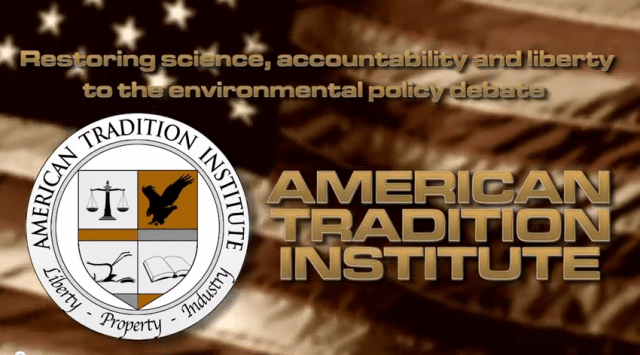Oh, the irony. A guy who built his career – and fortune – by muddying the science on the health effects of smoking is now accusing the E.P.A. of harming lungs and causing heart problems.
Steve Milloy, the former Big Tobacco flack who now runs the trashy haven for climate denial JunkScience.com, is waging a veritable war on the E.P.A. for their research on the effects of smog (or soot, or fine particulates, or PM 2.5 if you want to get really technical) on the cardiovascular and respiratory systems.
To hear Milloy describe it – on JunkScience or his newly launched website, EPAHumanTesting.com – the E.P.A. is running “illegal” and “unethical” experiments on human subjects. He’s got allies in this fight, most notably the American Tradition Institute (ATI), a think tank that purports itself as “restoring science, accountability, and liberty to the environmental policy debate.” Milloy is also a fellow at the ATI. On September 24, ATI sued the E.P.A. for “inhumane and illegal treatment of test subjects.”
If you recognize ATI and its lead attorney David Schnare, it might well be from some recent coverage of their role in the pestering of climate scientist Michael Mann. Last month, ATI and Schnare lost a legal battle to expose the Mann’s private emails, a feckless attempt at rehashing the Climategate nonstory, which Kate Sheppard reported on, and which Greg Laden expanded upon.
As Milloy frames this research – E.P.A. tests unwilling humans! – it’s perfect bait for radical conservative media outlets who will jump on any opportunity to bash the E.P.A.
What none of these articles will tell you, and what you can’t find on either Milloy’s or the ATI’s sites, are any of the following realties:
- These human subject experiments are entirely common, and frequently practiced by government agencies, the military, universities, other research entities, as well as pharmaceutical companies, and they are guided by strict rules and safety regulations (and third party oversight) under the Common Rule. In short, this is basic scientific process.
- All participants in the study were compensated volunteers (making $1,757 each), and were repeatedly told about exactly what the study involved, what they would be inhaling, how it would be delivered, and that they could stop at any point during the experiment under their own will. (Their health was also continuously monitored during the experiment.)
- The level of pollution inhaled by participants was no greater than that which would be experienced by walking down the streets in New York, Los Angeles, or Mexico City on a smoggy day.
Of course, none of those realities are going to stop someone like Oklahoma Republican Senator James Inhofe from calling for Senate hearings and saying that “the EPA may be criminally liable for its conduct.”
The scare stories certainly aren’t going to stop anytime soon, so it’s important that the reality of the research is better understood.
The E.P.A. has been reserved in responding to the lawsuit (too much so, if you ask me), but when Milloy’s accusations were first flung back in April, Wayne Cascio, a director with the agency in charge of the research, responded with a letter to the Washington Times, and it helps set the record straight.
Steve Milloy’s recent Op-Ed (“Did Obama’s EPA relaunch Tuskegee experiments?” Commentary, April 25) makes allegations about critical scientific research into how air pollution might contribute to abnormal heart rhythms.
The Environmental Protection Agency’s (EPA) research into the health impacts of air pollution has helped to build healthier communities, provide new technology and develop new solutions to protect and manage air quality. In the case of research into fine-particle pollution, more than 50 clinical studies over the past decade involving human volunteers have been published by scientists from the EPA, many U.S. universities and medical centers. These describe cardiac effects in humans exposed to this harmful pollution.
The EPA follows the Common Rule, which requires the ethical review and oversight of human research by an independent institutional review board (IRB) to ensure that any risks to study volunteers are minimized and justified. The EPA follows strict human safety protocols for all of its studies and these protocols are reviewed and approved by the IRB before any human study is conducted. Precautions are taken throughout the volunteer’s participation to ensure his safety. In the case of the EPA’s research on particle pollution, scientists studied biological changes that carry no or minimal risk while providing evidence for the reasons that particle pollution can lead to serious health problems.
The EPA has established health-based standards for fine-particulate matter, and these protect the public from serious health problems, including aggravated asthma, increased hospital admissions, heart attacks and premature death. Individuals particularly sensitive to fine-particle exposure include people with heart or lung disease, older adults and children.
In the United States, a heart attack occurs every 34 seconds and more than 2,200 people die of cardiovascular disease each day. It is estimated that tens of thousands of premature deaths and nonfatal heart attacks are triggered by air pollution, and this emphasizes the importance of research in this field. The health scientists and staff at the EPA are privileged to provide safe, ethical, unbiased and state-of-the-art inhalation science in support of the Clean Air Act as we work to define and understand the risks of air pollution to the American people.
Perhaps even more illustrative is the written declaration of Martin Case, one of the research study coordinators who administered the studies. You can read the whole document here (PDF), in which he explains exactly how the experiments are conducted, but here are a few relevant excerpts:
My first approach after being introduced to the subject by the medical station staff is to ask the subject if they have read the consent form. The subjects for CAPTAIN have been given the informed study consent form on a previous visit, and, they are also given the same consent to read again if they have not read the consent the day of the training.
My next approach is to ask the question: “Do you have any questions about what you have read, and do you understand what you have read?” Based on their response, this gives me the opportunity for me to judge whether I may need the principal investigator for the scientific aspect of the study, or, one of the medical doctors to answer anything that I think I may not be able to explain to the satisfaction of myself and to the subject.
Then based on my comfort level from that point, I go to what I consider the main assurance to the subject that he or she is not committed or obligated in anyway to what they have read or will sign about their participation for being in this study. I state very clearly that “their participation in this study and any study here at EPA is strictly and completely volunteer, and that they may stop their participation at anytime for any reason without any coercion whatsoever.”
Next I go into the details of the study (purpose). I always have a copy of the identical consent form in front of me as guidance. I explain what they will be receiving in the way of air pollution, how they will receive the air pollution, and describe how the air pollution is delivered in the chamber. I will explain to them that they will be receiving clean air on one day of the study, concentrated particles from the air outside the test building on the second day of the study, and the third day is a follow-up day. I will state in lay terms how they will be exposed to the particles for 2 hours, and explain what this is similar to (comparable to) as compared to going about their everyday activities based on where they live.
Next I go over the CAPTAIN medical screening questions about any reasons they should not participate in this study, and their requirements and compliance restrictions for being in this study.
Finally, I assure them of our concern for their safety first and foremost. Specifically, I tell them of the safe guards we have in place for monitoring their vitals signs, (e.g. EKG telemetry, blood pressure, and oxygen saturation; ‘especially while in the chamber’). I show the subject that they are always on camera, that they can just speak up to be heard, and that I am always just several feet away at the console watching them. As I am performing the training, I physically show them the controlled testing chambers and point out all of these features and safe guards that we have in place. In addition, I informed them of our emergency medical equipment, our overhead paging capability, immediate emergency response by our nurses, and that a dedicated on-call physician is always in the facility at all times when any study is taking place. I state again, “any questions.”
If this research was really as outrageous as Milloy and ATI are trying to make it sound, would the E.P.A. still be conducting the study? You’d think someone might have put the brakes on it. But, nope, they’re still recruiting participants.
If you’re between 50 and 75 years old and live close enough to the test facility in Chapel Hill, North Carolina, you could participate. You’d earn a cool $1,757 for 22 hours of your time. And your lungs won’t be any worse off than spending a smoggy summer day on the streets of Manhattan. (Which, of course, is not healthy at all! But that’s science!) It’s up to you. But don’t let Steve “Junk Man” Milloy confuse you with his scare tactics.
UPDATE: Next week, PBS Frontline will run “Dark Money” Group Central to Citizens United May Have Misled IRS, about the attacks on climate scientists via the American Tradition Institute, David Schnare, and Chris Horner. It’ll be one to watch, for sure.
Subscribe to our newsletter
Stay up to date with DeSmog news and alerts






